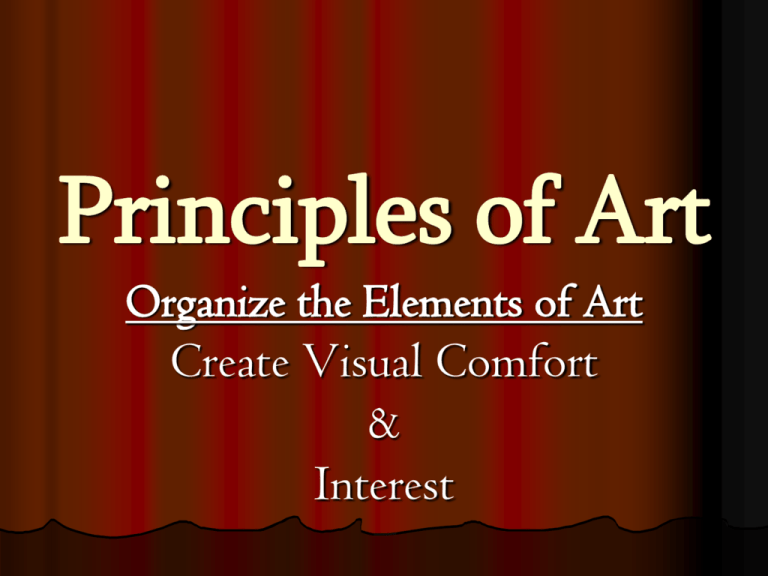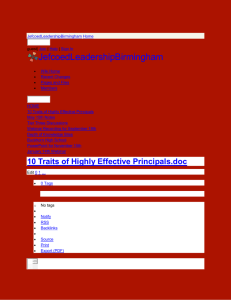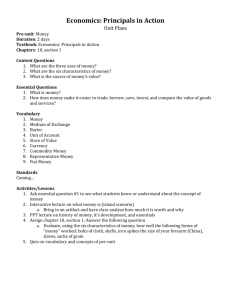What you notice Organize the Elements of Art
advertisement

Principles of Art Organize the Elements of Art Create Visual Comfort & Interest Why Use The Principals of Art? Why Use The Principals of Art? BALANCE Similar amount of information in two parts Symmetrical is exactly equal on both sides Asymmetrical unequal but balanced through color and/or design MOVEMENT Leads the eye to the focus of the image color, value (light to dark), long shapes, and lines guide the eye RHYTHM/REPITITION/PATTERN The same element is used over and over Regular repeating in a pattern Irregular repeating with no regular pattern CONTRAST/VARIETY Creates excitement (opposite of sameness = boring) Uses different Elements of Art together: sharp and soft edges, pattern and space, dark and light, bright and dull color, warm and cool color, smooth and rough texture, organic and geometric shapes. I like slugs! EMPHASIS The focus on an area Using the Elements of Art/Design (line, color, shape, form, space, value & texture) UNITY Looks like it belongs together Makes sense of the image, brings it together. (opposite of chaos) Uses same or similar Elements of Art/Design (line, color, shape, form, space, texture, & value) PROPORTION/SCALE The relative size of objects to one another Example: Use appropriate scale in surface design. An overly large textile design can overwhelm the form of a garment or a piece of furniture. FIGURE GROUND RELATIONSHIP What you notice The FIGURE(S) is/are the recognizable part we pay attention to, the positive shape(s). The GROUND is everything that is not the figure(s). PRINCIPALS OF ART SUMMARY Organize the Elements of Art 1.BALANCE: Similar amount of information in two parts 2.MOVEMENT: Leads the eye to the focus of the image 3.RHYTHM/REPITITION/PATTERN: 4.CONTRAST/VARIETY: 5.EMPHASIS: 6.UNITY: Opposite of sameness The focus on an area Looks like it belongs together 7.PROPORTION/SCALE: 8.FIGURE The same element used over & over The relative size of objects to one another GROUND RELATIONSHIP: What you notice Assignment: School/Class Rule Poster Using the poster guidelines (10 points) Cut out colored construction paper scraps and pieces of magazines in shapes representing each of the Elements of Art (6 points) Use all of the Principals of Art to organize the Elements (8 points) Write how you used each one with specific examples (14 points) Example: The orange thin rectangle is the Element of Art, line. I put it under the red sphere to add the Principal of Art, emphasis. (38 points) Assignment 2: Principals of Art Book 54 points Using the Principals of Art 2. NEATNESS COUNTS 3. Fold 2- 8 ½” x 11” sheets of paper in half vertically. Cover them with a slightly larger piece of colored construction paper. Staple them together at the fold. Include a title & your name on the cover. (6 points) 4. Each page of the book will represent one of the Principals of Art. ( 8 points) 5. You will label, define & draw each Principals of Art. ( 16 points) 6. Draw one Principal of Art per page using all of the Elements of Art on each page. (8 points) 7. On each page, using complete sentences, write how you used that Principal & the Elements of Art with specific examples. (16 points) Example: The Element of Art, line, is orange and it is around the red sphere to add the Principal of Art, emphasis. Red and orange are the Elements of Art, color, which are bright colors that also add to the Principal of Art emphasis. I used the Element of Art, value, to make the red circle look like a sphere and also uses the Element of art, space, because a sphere is 3D. I made little lines coming out of the sphere to look like hair which adds the Element of Art, texture. 1. Assignment 3: Analyzing 16 points per painting = 32 total Look at these pieces of artwork and describe how each of the Principals of Art are being used or not for each painting. Use complete sentences. Be very specific to that particular piece of artwork give examples from the art. Example: Unity is achieved through the off white background throughout the painting. Scoring: 1 point for each correctly identified Principal used 1 point for the specific supporting information There are 2 points possible per Principal There are 8 Principals There are a total of 16 points possible per painting analyzed 32 points for both pictures combined Wassily Kandinsky (1866-1944 Transverse Line, 1923, Oil on canvas Claude Monet - Water-Lilies -1914 REVIEW 1) 2) List the Principals of Art Describe each of the Principals of Art REFERENCES Monet www.writedesignonline.com/.../rules/color.html Kandinsky http://www.abstractart.com/abstraction/l2_grnfthrs_fldr/g029b_kand insky_tr_ln.html









